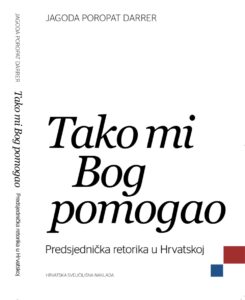In a super election year both in Croatia and in the world, and in anticipation of the Croatian presidential elections, university professor Jagoda Poropat Darrer published the book “So help me God” – presidential rhetoric in Croatia. The official book launch is scheduled for December 5th. For Diplomacy&Commerce magazine, she talks about all the secrets of the successful communication, visual rhetoric, gesticulation of the candidates. We also talked with her about the rhetoric of world leaders and the difference compared to domestic politicians.

- “So help me God” – presidential rhetoric in Croatia, is your first book. What inspired you to choose this topic?
The book was written partly as a result of many years of engagement with the rhetoric of Croatian and global political leaders, and partly from research for my doctoral thesis. My professional and academic interests lie in exploring how persuasive mechanisms work and how politicians gain, maintain, and lose the trust of voters. Many secrets are hidden not only in the direct verbal message but also in the voice, posture, behavior, and non-verbal cues. It is widely known that 38% of the overall impression we leave on our audience is created through the voice, or more precisely, prosodic features. In the book, among other things, I specifically address the tone and intonation of individual presidents and test whether there is something specific to which voters respond more favorably. It turns out that a lower tone and more natural intonation affect whether a president will be more liked by their voters. In addition to prosody, the book covers values, language and style, populist elements, and, of course, the visual rhetoric of individual presidents.
- How would you place the presidential rhetoric today in the Croatian rhetorical heritage and how would you evaluate it in general?
Croatian rhetorical heritage is very rich. When we look back at Croatian history, particularly during the time of the Republic of Dubrovnik, which was distinguished by its diplomacy, and then add to that the rhetoric of folk toasts, oaths (such as charms, curses, pledges, recommendations), praises, counting rhymes, and taunts, we can say that rhetoric in Croatia has always been very specific and vivid. Folk rhetoric is still present in the speeches of presidents. It often appears in an archaic form, through sayings, mottos, and proverbs that are abundant in their political speeches. Unfortunately, presidential rhetoric is filled with figures of speech, but they tend to be worn-out ones, which no longer feel like embellishments. Here we find many metaphors about path (track), construction, turning over a new page, and scenes— all overused figures. Therefore, it would be appropriate at this point to suggest to all public speakers to improve their use of metaphors, for example, as President Milanović does, who is by far the best in this respect among all the presidents analyzed in the book. Intelligent, well-read, and rhetorically agile, he always manages to capture attention with his speech, and not just when he makes provocative remarks.

- When we talk about the president’s rhetoric, we cannot exclude the fact that they are politicians and that their goal is to profit (get the most votes). How do the values in their speeches fit into that, and what about populism, which is inevitable, on the other hand?
Each person does this in their own unique way. One remarkable aspect of presidential elections in Croatia is that they are still direct elections. Every vote has equal value and can tip the balance in an election. All presidents emphasize universal values, but these values differ from president to president—partly due to the historical-political context in which they served, partly based on their political alignment (whether left or right), and also due to their individual personality and character. In the book, I also analyze how presidents build their credibility based on the values they emphasize. For example, I reveal how Tuđman placed the most emphasis on the value of freedom, Mesić on cooperation, Josipović on justice, Grabar-Kitarović on unity among citizens, while Zoran Milanović’s rhetoric is rooted in the values of equality in diversity, truth, independence, cooperation, the cultivation of national culture, patriotism, and solidarity. As the supreme commander of the armed forces, he particularly focuses on and addresses national security issues in his speeches.
When discussing populism, it is essential not to confuse different concepts. Populism exists as a meta-ideology and, as such, encompasses three elements: anti-elitism, an appeal to the people, and the identification of a dangerous “other.” It should not be confused with populist communication style, which is a tactic used to gain voter support. One of the conclusions in the book is that Croatian presidents are not populists by definition, but some employ a populist style to varying degrees. For example, by emphasizing that they are just ordinary people, showing their love for football, sharing glimpses of their family life with voters, promising popular measures they cannot fulfill, or using dialects to connect with citizens. It’s worth noting that in the analyzed speeches of Croatian presidents, I did not detect right-wing populism, which is currently prominent in Europe.
- How important is visual rhetoric in the addresses of presidents and politicians in general, and what does it actually mean?
Visual elements contribute to the persuasive power of discourse, with the aim of achieving a positive rhetorical effect. The elements of visual rhetoric are employed both deliberately and unintentionally, and persuasion in visual rhetoric can occur on two levels: consciously and subconsciously, both for the sender and the recipient of the visual message. Persuasive elements include proxemics, kinesics, and symbolic repertoire, while the strategy of persuasion relates to the use of ethos and pathos. This means that all visual elements are directed towards building the president’s credibility (through the strategy of persuasion via ethos) and representing the independence of the Republic of Croatia to a broad audience both domestically and internationally. Additionally, unintentional non-verbal cues from presidents complement the core verbal messages of their speeches, enhancing the persuasive strength of the discourse and reinforcing national identity.
- Which of the Croatian presidents so far (Franjo Tuđman, Stjepan Mesić, Ivo Josipović, Kolinda Grabar Kitarović, Zoran Milanović) has the most impressive rhetoric and who would you single out as someone who most respects the “rules” when communicating?
When it comes to following rhetorical rules, I must say that President Josipović adhered to them the most, although this earned him the title of the most boring and least engaging speaker. The goal, therefore, is not to strictly follow general rules, but to be innovative and authentic in public appearances. According to respondents, the best speaker was Franjo Tuđman, particularly in the categories of expressiveness, emotionality, sincerity, persuasiveness, and audience engagement. Zoran Milanović received the highest rating for naturalness among all presidents. Stjepan Mesić was most appreciated for the pleasantness of his voice and clarity of speech, while Kolinda Grabar-Kitarović was rated highest in emotionality. Although Franjo Tuđman was rated the highest in several categories, he also received the most negative comments in the open-ended responses from some participants. Tuđman was praised for his energy, passion, and fervor, but criticized for theatricality, pathos, and an unpleasant voice and delivery. Stjepan Mesić was most liked for his pleasant voice, conciliatory tone, and calmness, though he was faulted for self-praise, lack of emotion, and monotony. Ivo Josipović was praised for his diction, pacing, and pronunciation, but criticized for being unconvincing, having a plaintive and non-leaderly voice, and lacking charisma. Kolinda Grabar-Kitarović was attributed with ambition, power, passion, and emotionality, while her affectation, pathos, and lack of authenticity were criticized. Zoran Milanović was praised as a confident speaker but was criticized for using ad hominem arguments against opponents and for insulting them.
- A special segment of the book is the rhetoric of the current president, Zoran Milanović. Is it because of his special way of speaking, expression, unconventionality or something else? How would you describe his rhetoric?
It could indeed be concluded that a separate chapter naturally imposed itself due to the peculiarities of the current president, but this is actually just a technical maneuver since the doctoral research did not originally include Milanović.
The most interesting part of Zoran Milanović’s rhetorical profile is his speaking style. His abundant and original use of figurative language is the hallmark of his rhetoric. The popularity of such original rhetorical figures has reached the point where Milanović’s coinages have earned the term “zoranisms.” We could say that Milanović is a master of this kind of rhetoric, but also of improvisation, as he always incorporates his own authentic and spontaneously crafted, sometimes provocative, phrases into his prepared speeches. Milanović’s style, marked by scandalizing rhetoric, blends authenticity with a provocative edge, often generating both public engagement and controversy. His tendency to break conventional rules of political discourse makes him stand out but also fuels significant debate about the appropriateness and effectiveness of his rhetoric.
- Your book deals with the rhetoric of Croatian presidents, but which of the world’s officials (presidents) is the most interesting to you in terms of communication and ways of addressing both official and less formal (Biden, Trump, Macron, Putin…)?
The presidents you mention cannot be measured by the same standards as Croatian presidents because they come from a presidential system of governance, where the president holds actual executive power, which is not the case in Croatia. In any case, every word and action of these foreign leaders has a much greater impact. They are each interesting in their own way. It’s fascinating to observe how today’s most prominent politicians use rhetoric—this oldest political tool—to gain the trust of voters, or how they fail to use it for their own purposes. The most vivid example is, of course, Donald Trump, with his scandalous rhetoric and angry populism. Then there’s “Sleepy Joe,” as Biden is often called due to his slow reactions and odd behavior in his addresses to the nation. Putin presents a different case, built on the cult of personality and the infallibility of a supreme leader. Macron, with his political power somewhat shaken, seems to be losing the charisma he had long cultivated. It’s also intriguing to reflect on Trump’s populist style. In his rhetoric, he emphasizes elements typical of populist discourse. He claims to be “from the people,” distancing himself from political elites, which he identifies as the corrupt Democrats. He also insists that he is the only one capable of saving the U.S. and establishing peace worldwide. This is a classic populist approach, positioning himself as the savior of the world.